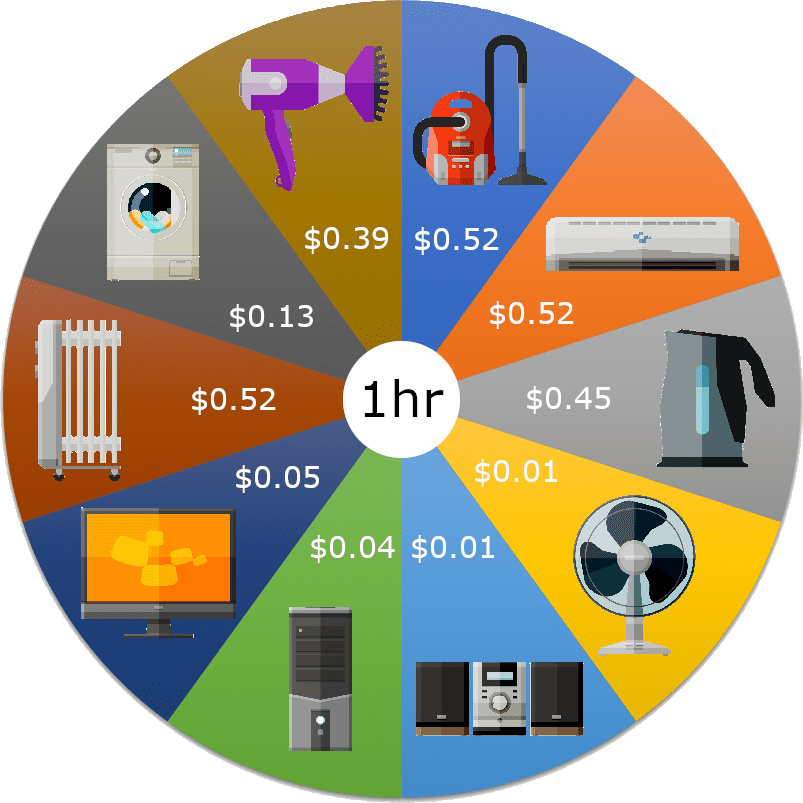
Team GI have been designing and installing solar in Australia since 2011. The electrical terminology retailers use when sending you their invoice is second nature to us. When we turn the kettle on in the morning, or the AC on after work, we know exactly how these appliances will affect our looming energy bill.
However, we understand that unless you are in the electrical industry in some capacity, most people have no idea how to work out how much electrical appliances cost to use.
This is why so many Australians get the dreaded fear when opening that horrible little letter from their energy retailer every billing period. Or when we sigh when we see the email hit in the inbox from our electrical company.
It is simply not a purchase that most people understand. Which is kind of weird when you think about it. We spend more money on electricity than we do on gym memberships, cinema tickets, breakfasts at the local café and even beer!
OK, so the last one is only true for some of us… but the point remains. We spend thousands of dollars every year, on electricity for our home, and 90% of us have no idea how to calculate our costs, and how to save our money on one of our biggest expenses.
So, let’s take 5 minutes of our time, to read this and understand what we are spending our hard-eared money on.
Comparing devices
How electricity is measured, and what does it cost per “unit”
Your electricity usage is charged by the kWh and is measured by your electricity meter.
kWh is short for kilowatt-hour, a unit of energy.
- Kilo (symbol is little k) means 1000
- Watt (symbol capital W) is the unit of power
- Hour (h) is…well, 60 minutes.
So 1kWh means you use 1kW (1000W of power) for one hour.
The amount you pay for each kWh depends on your tariff. As a guide, most residential tariffs are in the range 20c to 40c/kWh; we’ll use 30c/kWh in the examples below.
A worked example
A microwave may be rated at 1000W. This means, when it’s in use, it uses 1000W – or 1kW.
If you have the microwave on for 1 hour, it will use 1000Wh. At 30c/kWh, this would cost 30c.
If you used it for 6 minutes (1/10th of an hour), it would use 1000W x (1/10)h = 100W (=0.1kW). At 30c/kWh, this would use 3c (30c x 0.1kW).
Different devices use a different amount of energy
Your appliance has a power rating, telling you how much power it uses. This is often found in the instruction manual or on a sticker on the device. Here are some examples of typical appliance power ratings:
- Light globes: 5W to 100W
- Computer, TV, big sound system: 150W to 200W
- Microwave, toaster, vacuum, hair dryer, kettle: 1000W to 2000W
- Clothes dryer: 3000W
There is also a government program where appliances have Energy Rating labels. This gives a rating of how energy efficient an appliance is, and the expected energy usage per year in kWh. The more stars and the lower consumption the better!
Assuming $0.30c/kWh, these charts show how many hours you can run a device for $1. The first is a linear scale (the left scale goes up every 200) – which makes it hard to see the small ones. The second is a logarithmic scale, which makes it easier to see the smaller ones – note the left scale goes up by 10x every major gridline. The data in both graphics is the same (see the numbers above each bar).
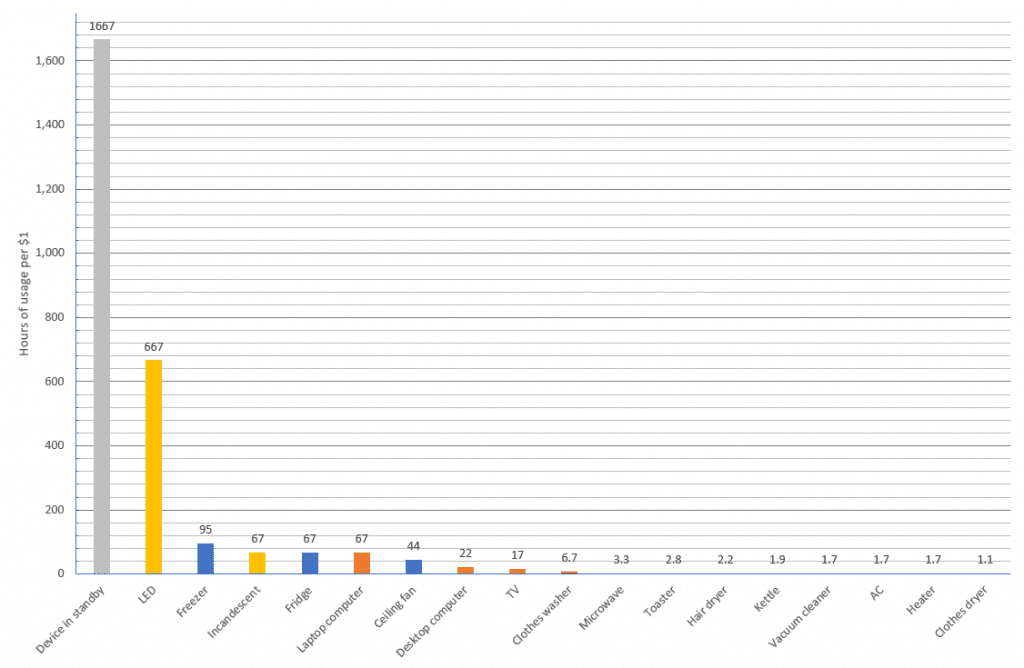
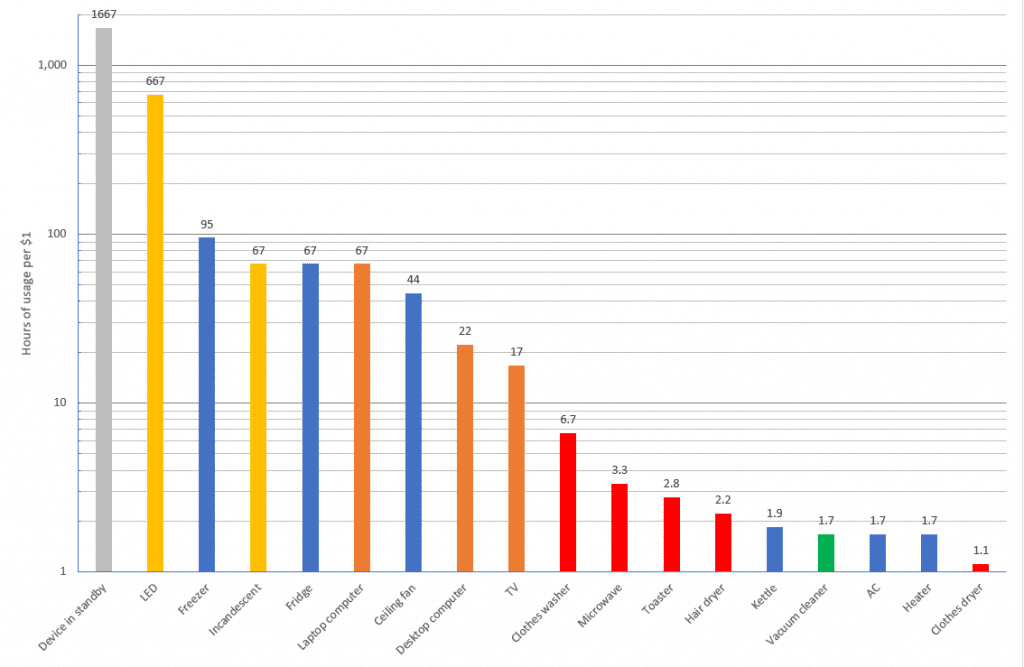
Replacing inefficient appliances
Although it costs money to replace an appliance, it could save you money in the long term – lights are a good example of this (see the yellow bars in the above bar charts). Imagine you have 10 lightbulbs and they run for 8 hours a day. If they were 100W bulbs, they would use 100W x 10 x 8hrs = 8kW per day (at 30c/kWh, that’s $2.40 per day).
If they were 5W bulbs, they would use 5W x 10 x 8hrs = 0.4kW per day (at 30c/kWh, $0.12 per day). That means every day you’re using the 5W bulbs you’re saving $2.28.
If it cost you $200 to replace the bulbs, it would take less than 3 months to recoup your cost and start saving money.
Are devices always using maximum power?
Some appliances don’t use their maximum potential power all of the time and automatically vary their power based on the situation. An example of this is air conditioning. An AC unit may be rated at 3kW, but it will only use that much energy if it’s on maximum – fan on full, Turbo mode activated, to cool down a 35°C room down to 22°C as fast as possible. If the room is already at 22°C and the AC is just maintaining that temperature, it will use a lot less power – perhaps only 0.3kW. Relatedly, your fridge isn’t using maximum power all the time – only when it detects the temperature is higher than what it is configured to maintain.
Some appliances do use their maximum power rating all the time. A kettle is a good example of this – it is either on or off, using 100% of the available power or 0%.
Some appliances use different amounts of energy based on the setting. For example, a tumble dryer might have warm, hot, and extra hot settings. The hotter the setting, the more power it will use. And (usually) having your TV on standby will still draw some electricity, whereas if you turn it off at the wall, it will not be drawing any electricity at all.
How to monitor your usage
Use a plug-in meter for accurate monitoring
Using this you can make a rough estimation of what in your house is using the most power and costing you the most. However, if you’re really curious you can buy a plug-in electricity meter from a shop such as Bunnings. This goes between your device plug and the wall socket, and directly measures the energy used. Leave it in for an hour or a week and you’ll know exactly how much a certain device uses!
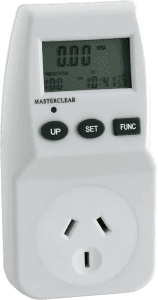
Energy provider apps
If you have a digital meter, your usage is constantly being sent to your energy retailer. For example, the AGL app tells you how much electricity you used each day and how much it has cost you. It can even break it down throughout the day, so you can see the peaks and troughs – for example, when you accidentally left the AC on!
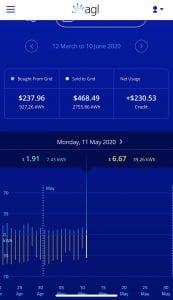
Solar metering
Solar metering tends to be the most informative. When you are able to view your live solar production levels and compare them on the same graph as your live consumption levels you can make very specific choices about how to use solar energy more often – for example, if you can see you’re exporting a lot during certain hours, you can shift your usage to that time period using timers.
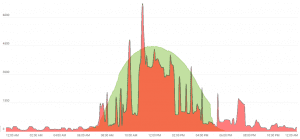
Conclusion
So, next time you buy a new appliance maybe check the energy rating a little more carefully. It’s actually pretty easy once you understand how things work to calculate how much it is going to cost you to own.
Or next time you decide to turn on that dryer you may look outside, see the bright sunshine and think about getting those clothes out to dry in the clean, free clothes dryer the beautiful Australian climate has blessed us with 90% of the time 😉










